Abstract
A method for quantifying eubacterial cell densities in dilute communities of small bacterioplankton is presented. Cells in water samples were stained with 4',6-diamidino-2-phenylindole (DAPI), transferred to gelatin-coated slides, and hybridized with rhodamine-labeled oligonucleotide probes specific for kingdom-level 16S rRNA sequences. Between 48 and 69% of the cells captured on membrane filters were transferred to gelatin-coated slides. The number of DAPI-stained cells that were visualized with eubacterial probes varied from 35 to 67%. Only 2 to 4% of these cells also fluoresced following hybridization with a probe designed to target a eukaryotic 16S rRNA sequence. Between 0.1 and 6% of the bacterioplankton in these samples were autofluorescent and may have been mistaken as cells that hybridized with fluorescent oligonucleotide probes. Dual staining allows precise estimates of the efficiency of transfers of cells to gelatin films and can be used to measure the percentage of the total bacterioplankton that also hybridize with fluorescent oligonucleotide probes, indicating specific phylogenetic groups.
Full text
PDF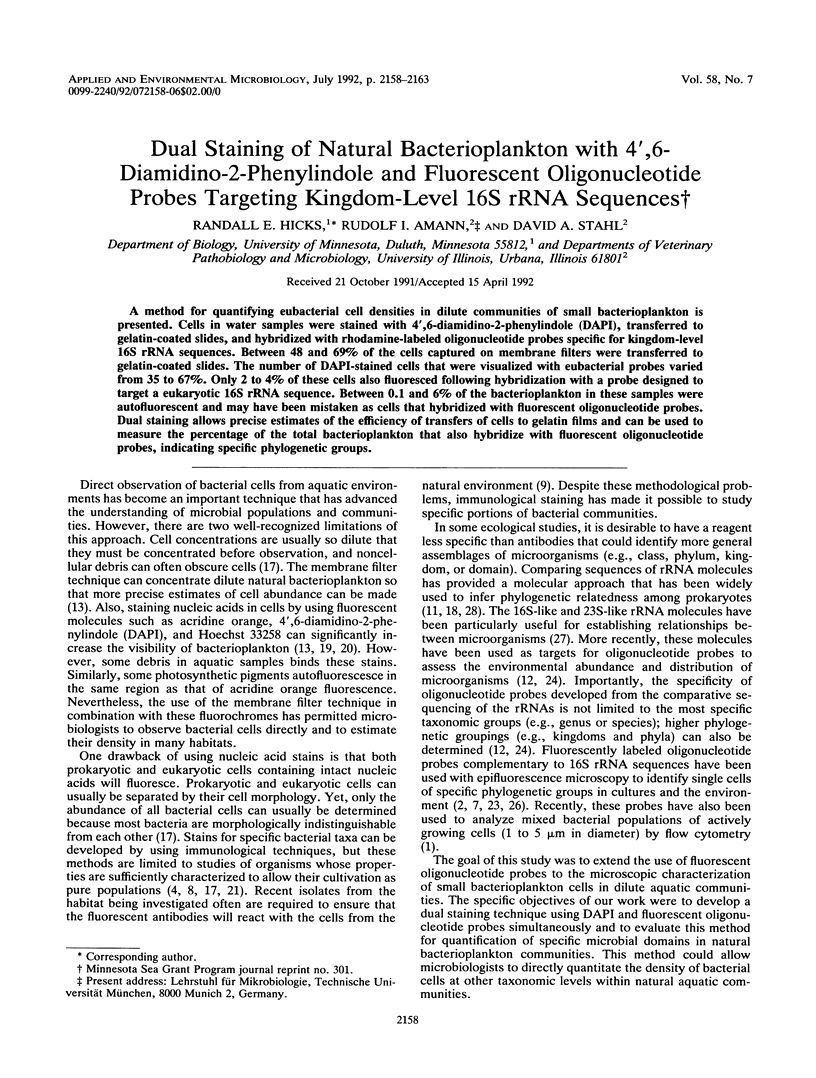
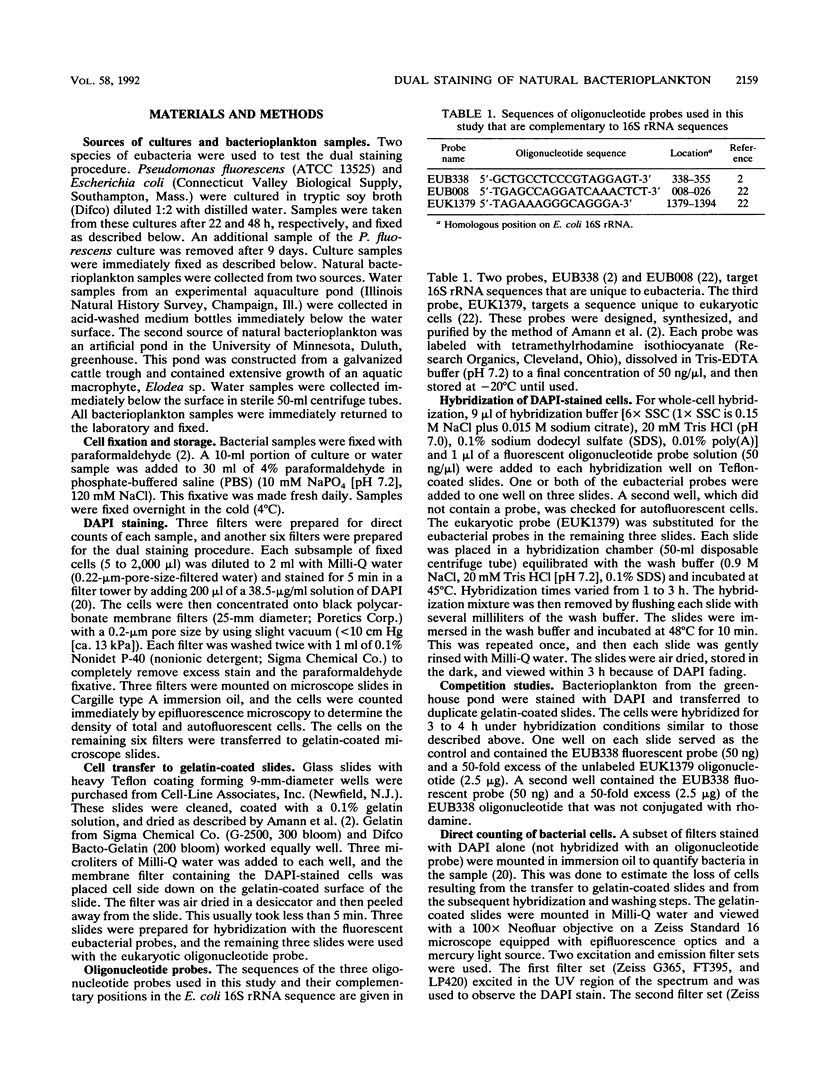
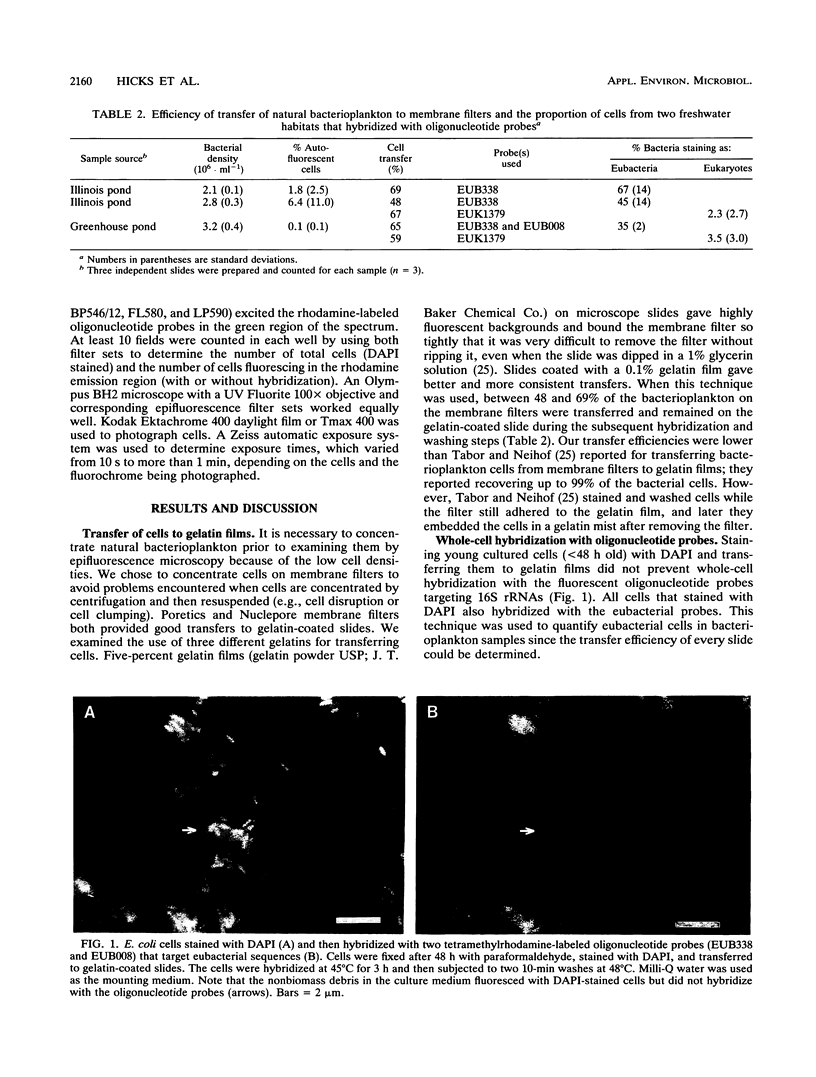
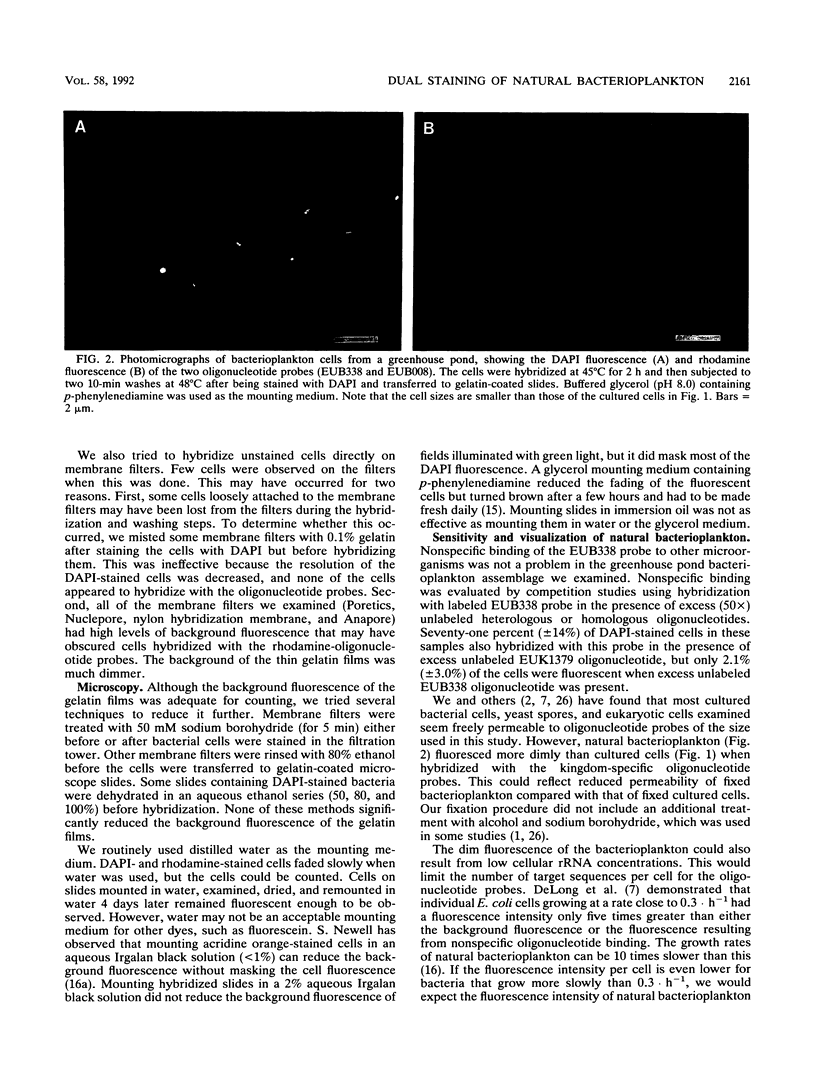
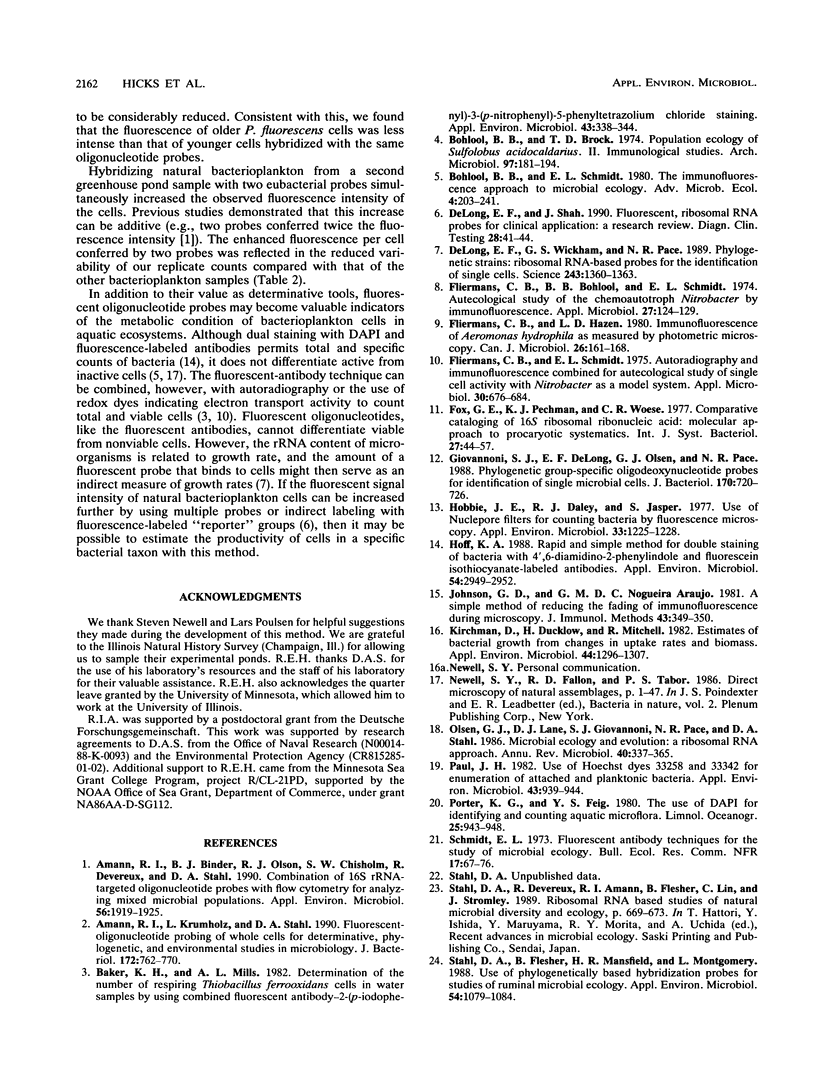

Images in this article
Selected References
These references are in PubMed. This may not be the complete list of references from this article.
- Amann R. I., Binder B. J., Olson R. J., Chisholm S. W., Devereux R., Stahl D. A. Combination of 16S rRNA-targeted oligonucleotide probes with flow cytometry for analyzing mixed microbial populations. Appl Environ Microbiol. 1990 Jun;56(6):1919–1925. doi: 10.1128/aem.56.6.1919-1925.1990. [DOI] [PMC free article] [PubMed] [Google Scholar]
- Amann R. I., Krumholz L., Stahl D. A. Fluorescent-oligonucleotide probing of whole cells for determinative, phylogenetic, and environmental studies in microbiology. J Bacteriol. 1990 Feb;172(2):762–770. doi: 10.1128/jb.172.2.762-770.1990. [DOI] [PMC free article] [PubMed] [Google Scholar]
- Baker K. H., Mills A. L. Determination of the Number of Respiring Thiobacillus ferrooxidans Cells in Water Samples by Using Combined Fluorescent Antibody-2-(p-Iodophenyl)-3-(p-Nitrophenyl)-5-Phenyltetrazolium Chloride Staining. Appl Environ Microbiol. 1982 Feb;43(2):338–344. doi: 10.1128/aem.43.2.338-344.1982. [DOI] [PMC free article] [PubMed] [Google Scholar]
- Bohlool B. B., Brock T. D. Population ecology of Sulfolobus acidocaldarius. II. Immunoecolgical studies. Arch Microbiol. 1974 May 16;97(3):181–194. doi: 10.1007/BF00403057. [DOI] [PubMed] [Google Scholar]
- DeLong E. F., Wickham G. S., Pace N. R. Phylogenetic stains: ribosomal RNA-based probes for the identification of single cells. Science. 1989 Mar 10;243(4896):1360–1363. doi: 10.1126/science.2466341. [DOI] [PubMed] [Google Scholar]
- Fliermans C. B., Bohlool B. B., Schmidt E. L. Autecological study of the chemoautotroph Nitrobacter by immunofluorescence. Appl Microbiol. 1974 Jan;27(1):124–129. doi: 10.1128/am.27.1.124-129.1974. [DOI] [PMC free article] [PubMed] [Google Scholar]
- Fliermans C. B., Hazen T. C. Immunofluorescence of Aeromonas hydrophila as measured by fluorescence photometric microscopy. Can J Microbiol. 1980 Feb;26(2):161–168. doi: 10.1139/m80-024. [DOI] [PubMed] [Google Scholar]
- Fliermans C. B., Schmidt E. L. Autoradiography and immunofluorescence combined for autecological study of single cell activity with Nitrobacter as a model system. Appl Microbiol. 1975 Oct;30(4):676–684. doi: 10.1128/am.30.4.676-684.1975. [DOI] [PMC free article] [PubMed] [Google Scholar]
- Giovannoni S. J., DeLong E. F., Olsen G. J., Pace N. R. Phylogenetic group-specific oligodeoxynucleotide probes for identification of single microbial cells. J Bacteriol. 1988 Feb;170(2):720–726. doi: 10.1128/jb.170.2.720-726.1988. [DOI] [PMC free article] [PubMed] [Google Scholar]
- Hobbie J. E., Daley R. J., Jasper S. Use of nuclepore filters for counting bacteria by fluorescence microscopy. Appl Environ Microbiol. 1977 May;33(5):1225–1228. doi: 10.1128/aem.33.5.1225-1228.1977. [DOI] [PMC free article] [PubMed] [Google Scholar]
- Hoff K. A. Rapid and simple method for double staining of bacteria with 4',6-diamidino-2-phenylindole and fluorescein isothiocyanate-labeled antibodies. Appl Environ Microbiol. 1988 Dec;54(12):2949–2952. doi: 10.1128/aem.54.12.2949-2952.1988. [DOI] [PMC free article] [PubMed] [Google Scholar]
- Johnson G. D., Nogueira Araujo G. M. A simple method of reducing the fading of immunofluorescence during microscopy. J Immunol Methods. 1981;43(3):349–350. doi: 10.1016/0022-1759(81)90183-6. [DOI] [PubMed] [Google Scholar]
- Kirchman D., Ducklow H., Mitchell R. Estimates of bacterial growth from changes in uptake rates and biomass. Appl Environ Microbiol. 1982 Dec;44(6):1296–1307. doi: 10.1128/aem.44.6.1296-1307.1982. [DOI] [PMC free article] [PubMed] [Google Scholar]
- Olsen G. J., Lane D. J., Giovannoni S. J., Pace N. R., Stahl D. A. Microbial ecology and evolution: a ribosomal RNA approach. Annu Rev Microbiol. 1986;40:337–365. doi: 10.1146/annurev.mi.40.100186.002005. [DOI] [PubMed] [Google Scholar]
- Paul J. H. Use of hoechst dyes 33258 and 33342 for enumeration of attached and planktonic bacteria. Appl Environ Microbiol. 1982 Apr;43(4):939–944. doi: 10.1128/aem.43.4.939-944.1982. [DOI] [PMC free article] [PubMed] [Google Scholar]
- Stahl D. A., Flesher B., Mansfield H. R., Montgomery L. Use of phylogenetically based hybridization probes for studies of ruminal microbial ecology. Appl Environ Microbiol. 1988 May;54(5):1079–1084. doi: 10.1128/aem.54.5.1079-1084.1988. [DOI] [PMC free article] [PubMed] [Google Scholar]
- Tabor P. S., Neihof R. A. Improved method for determination of respiring individual microorganisms in natural waters. Appl Environ Microbiol. 1982 Jun;43(6):1249–1255. doi: 10.1128/aem.43.6.1249-1255.1982. [DOI] [PMC free article] [PubMed] [Google Scholar]
- Tsien H. C., Bratina B. J., Tsuji K., Hanson R. S. Use of oligodeoxynucleotide signature probes for identification of physiological groups of methylotrophic bacteria. Appl Environ Microbiol. 1990 Sep;56(9):2858–2865. doi: 10.1128/aem.56.9.2858-2865.1990. [DOI] [PMC free article] [PubMed] [Google Scholar]
- Woese C. R. Bacterial evolution. Microbiol Rev. 1987 Jun;51(2):221–271. doi: 10.1128/mr.51.2.221-271.1987. [DOI] [PMC free article] [PubMed] [Google Scholar]
- Woese C. R., Fox G. E. Phylogenetic structure of the prokaryotic domain: the primary kingdoms. Proc Natl Acad Sci U S A. 1977 Nov;74(11):5088–5090. doi: 10.1073/pnas.74.11.5088. [DOI] [PMC free article] [PubMed] [Google Scholar]




